Overview
We understand that effectively implementing legacy integrated technologies within organizations is not just a task; it’s a strategic imperative. A comprehensive assessment of existing systems is essential, as is engaging stakeholders throughout the process. By establishing clear integration strategies and ensuring ongoing support, we can facilitate a smooth transition that enhances operational efficiency. Our successful case studies and statistics underscore the tangible benefits of these approaches.
What’s holding your team back from embracing this opportunity? Let’s work together to unlock the full potential of your technology landscape.
Introduction
In a rapidly evolving technological landscape, organizations frequently grapple with the complexities of integrating legacy systems with modern solutions. We recognize this challenge and present Avato as a beacon of hope, offering a secure hybrid integration platform designed specifically for such hurdles.
This article explores essential strategies we can adopt to streamline our integration processes, including:
- Conducting thorough assessments of our existing systems
- Engaging stakeholders across departments
By embracing a structured approach and leveraging Avato’s capabilities, we can modernize our operations while enhancing security, performance, and overall value—ultimately transforming customer experiences in sectors like banking and healthcare.
As we strive to remain competitive, understanding and implementing these integration strategies will be crucial in navigating the complexities of today’s digital landscape.
What’s holding your team back from achieving seamless integration?
Avato: Secure Hybrid Integration Platform for Legacy Technologies
At Avato, we recognize the critical importance of dedication in technology integration. Our hybrid linkage platform is specifically designed for legacy integrated technologies, empowering organizations to seamlessly connect diverse platforms and data sources. We enable businesses to modernize their operations without compromising security or performance.
With features such as real-time monitoring, we equip banking IT managers to proactively address system performance challenges. Our support for 12 levels of interface maturity ensures a tailored approach that significantly reduces costs and unlocks data and systems in weeks, not months. This capability is particularly beneficial for industries like banking and healthcare, where secure and reliable connections are essential.
Ultimately, we enhance business value and transform customer experiences. What’s holding your team back from achieving this level of efficiency? We invite you to arrange a consultation with our specialists to explore how Avato can simplify your merging processes.
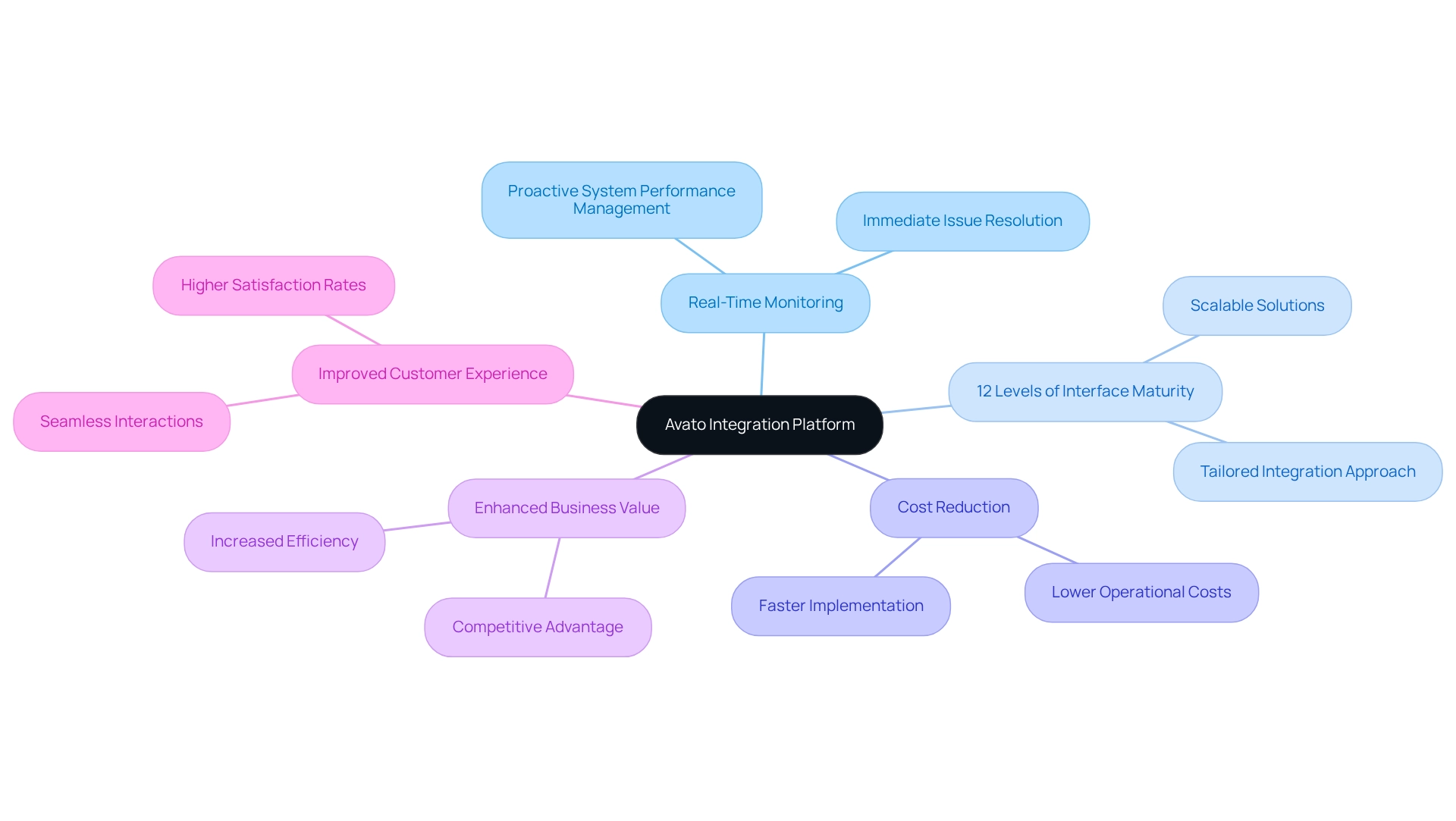
Conduct Comprehensive Assessments of Existing Legacy Systems
Carrying out a comprehensive evaluation of current legacy frameworks is crucial before we execute any unification approach. This process involves a thorough assessment of the existing architecture, recognition of essential dependencies, and a complete understanding of data flows within the structures. By uncovering inefficiencies and potential risks, we can craft a tailored integration plan that addresses specific challenges while capitalizing on existing strengths.
What’s holding your team back? Studies show that a considerable portion of organizations acknowledge shortcomings in their outdated frameworks, which can impede innovation and development. In fact, a 2018 report emphasized that software developers allocate an estimated $300 billion each year maintaining these outdated structures, diverting resources from modernization efforts. Furthermore, we could innovate much faster if we could allocate 50% of our budget towards innovation instead of legacy maintenance.
Legacy integrated technologies serve as strategic obstacles that impact various facets of business, including speed, innovation, customer experience, security, compliance, and overall growth. Best practices for assessing legacy systems in 2025 include:
- Engaging cross-functional teams to ensure all perspectives are considered
- Utilizing automated tools for data flow analysis
- Prioritizing security and compliance in the evaluation process
Organizations such as OSME Pacific and BC Provincial Health Services Authority have effectively maneuvered through this assessment stage, resulting in enhanced coordination efforts and improved operational efficiency.
Avato’s hybrid integration platform exemplifies our dedicated approach to simplifying these complex challenges. Expert insights highlight that legacy code frequently includes valuable patterns that can be replicated in contemporary systems, enhancing management and security. By prioritizing a thorough evaluation of legacy architecture, we ensure a smoother transition to integrated systems, ultimately fostering innovation and maintaining a competitive advantage. As Gustavo Estrada pointed out, “Avato has the capacity to clarify intricate projects and provide outcomes within specified timelines and budget limitations,” underscoring the significance of appropriate evaluation in attaining successful incorporation.
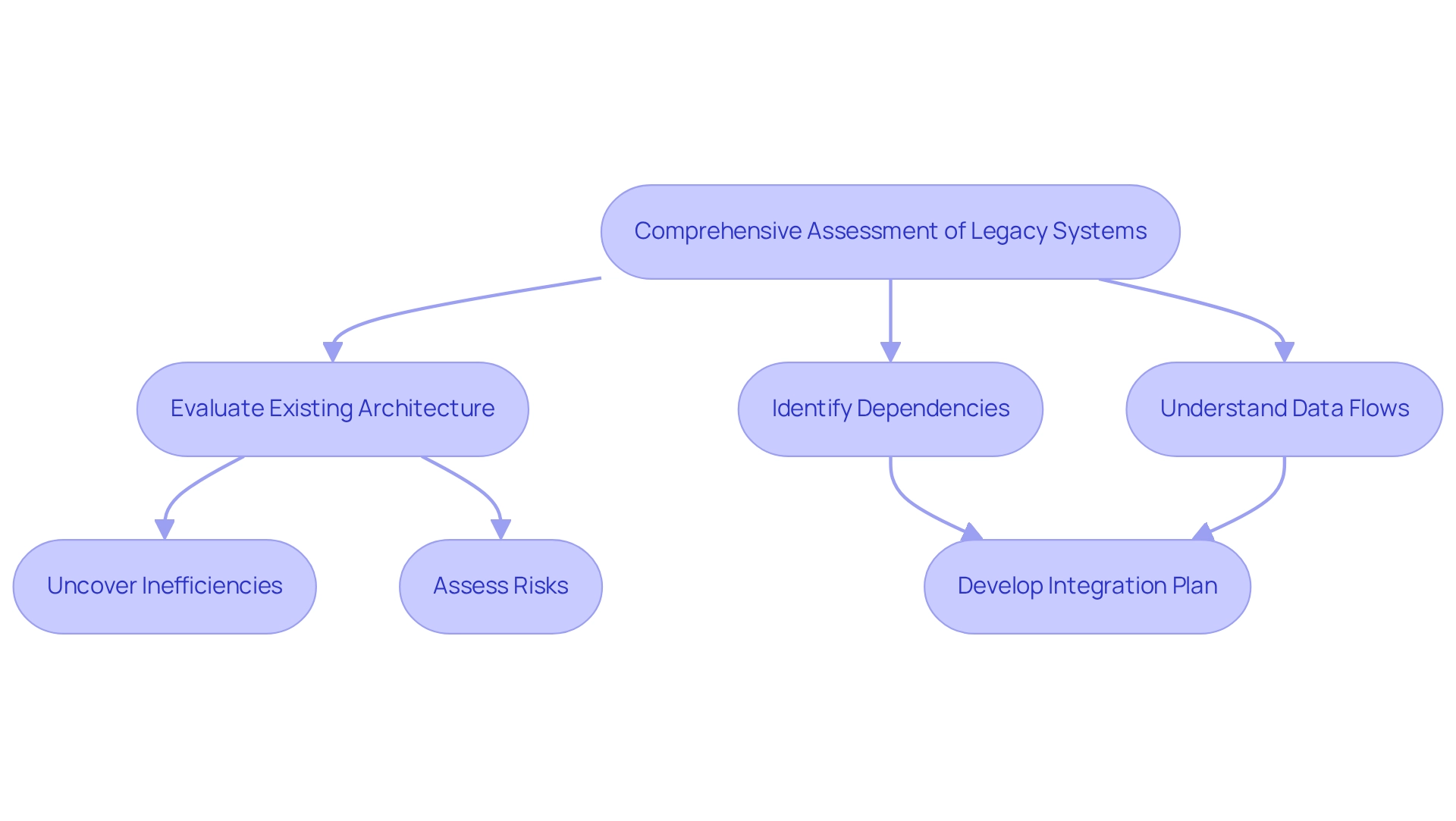
Develop a Clear Integration Strategy for Legacy Technologies
A clearly defined unification approach is crucial for the success of any legacy system merger project. We must outline our incorporation objectives, the technologies we will employ, and the implementation timeline. It is essential to assess the potential impact on business operations and develop contingency plans to address unforeseen challenges. By aligning our unification strategy with overarching business objectives, we not only ensure that the unification process adds value but also enhance operational efficiency.
Our skilled unification services, bolstered by a dedicated hybrid connection platform, empower entities to navigate these complexities effectively. By collaborating with proficient specialists, we enable companies to utilize our global partnership services, accelerating their digital transformation efforts.
Statistics reveal that entities actively overseeing their networks experience a 40% reduction in downtime, underscoring the significance of a proactive strategy. Furthermore, a joint survey by Mulesoft and Deloitte indicates that companies now utilize an average of 976 applications, with only 28% integrated. This increasing complexity necessitates robust coordination approaches to efficiently manage these networks.
Expert opinions emphasize that effective incorporation tactics for legacy frameworks must be tailored to the specific requirements of each entity. For instance, in the banking and healthcare sectors, where secure and dependable connections are paramount, establishing clear strategies for system integration has resulted in higher success rates in projects. By developing a comprehensive unification plan for legacy systems in 2025, we can effectively address the challenges posed by incompatible legacy platforms and custom-built applications, thereby optimizing our operations and fostering innovation. As Sarah Lee aptly stated, “The future belongs to those who dare to streamline, integrate, and innovate.” Additionally, leveraging our team extension services can be vital for building scalable development teams, further enhancing the effectiveness of our collaboration strategies.
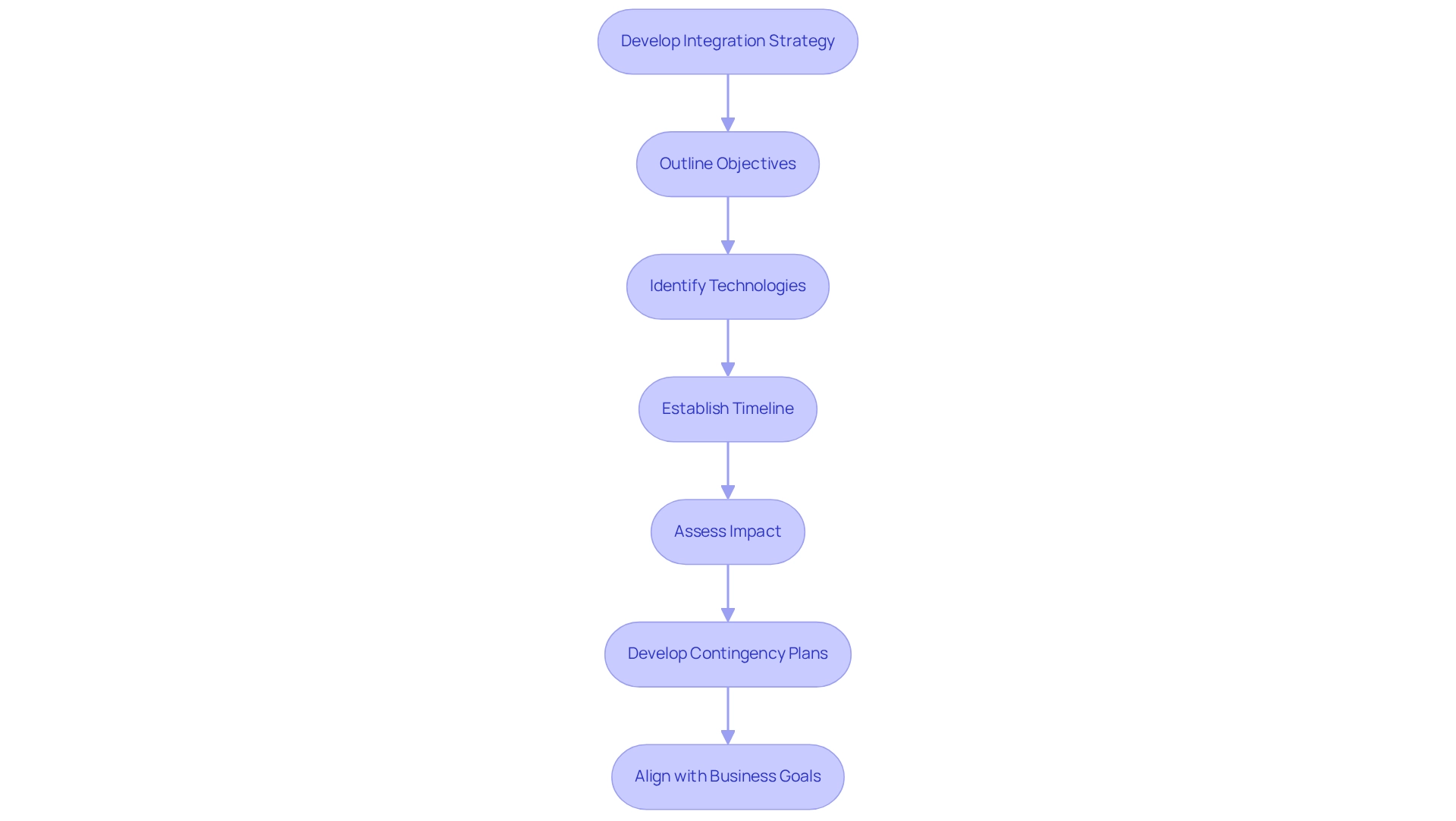
Engage Stakeholders Across Departments for Successful Integration
Involving stakeholders from various departments—such as IT, operations, finance, and end-users—is crucial for the success of legacy technology implementation. Engaging these stakeholders early in the process allows us to gather valuable insights, address concerns, and ensure that the integration aligns with the diverse needs of all parties involved. Effective communication is vital; it fosters transparency and builds trust, which are essential for collaboration. As Dinesh Paliwal stated, “Collaboration is a key part of the success of any organization, executed through a clearly defined vision and mission and based on transparency and constant communication.” Consistent feedback cycles not only sustain momentum but also nurture a culture of collaboration throughout the unification process.
Successful instances of cross-department collaboration highlight the significant impact of stakeholder involvement on unifying efforts. Organizations that prioritize collaboration often experience enhanced productivity and reduced costs, as they can swiftly adapt to changing demands. Avato guarantees 24/7 availability for essential connections, demonstrating how effective stakeholder involvement contributes to reliability and success in project implementations. With our robust hybrid connection platform, Avato accelerates secure system unification, establishing itself as a dependable partner for banking, healthcare, and government sectors.
Strategies for engaging stakeholders include:
- Establishing clear communication channels
- Defining roles and responsibilities
- Creating a shared vision for the project
By employing these strategies, we can navigate the challenges of legacy integrated technologies more effectively, ensuring a smoother transition and improved outcomes. Avato’s collaborative approach, underscored by successful unification projects, emphasizes the importance of collaboration in achieving unification objectives.
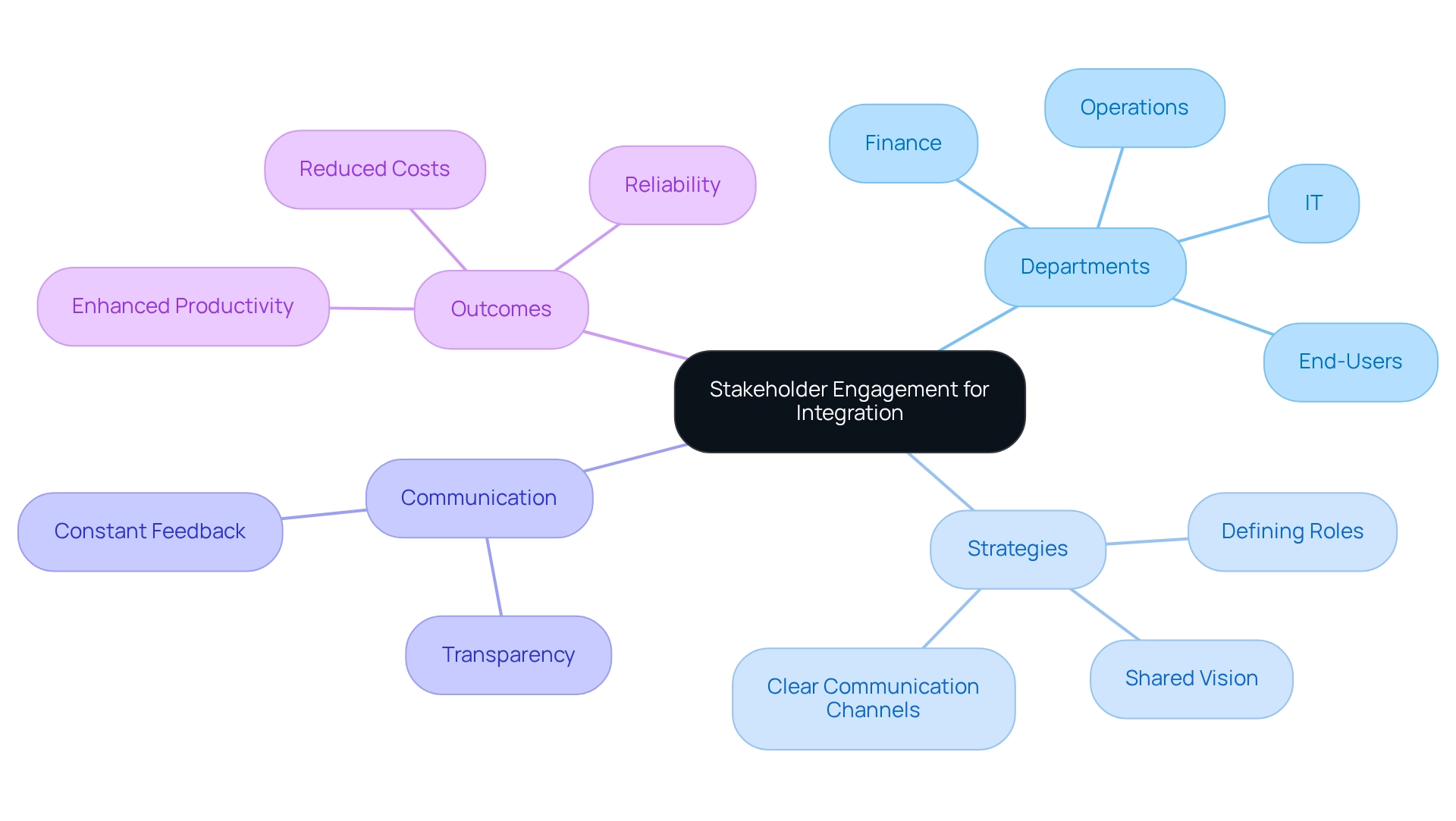
Provide Training for Staff on New Integrated Technologies
Providing training for staff on new integrated technologies is not just beneficial; it’s essential for minimizing disruptions and ensuring a seamless transition. At Avato, we advocate for investing in comprehensive training programs tailored to meet the specific needs of different user roles, particularly concerning our hybrid integration platform. These programs should incorporate:
- Hands-on sessions
- Online resources
- Continuous support
- Effective change management strategies
to foster a culture of innovation within your company. By equipping employees with the necessary skills and knowledge, we can significantly enhance user confidence, leading to quicker adoption of new systems. This proactive strategy not only enhances productivity but also effectively tackles challenges that may arise during the merging process.
Moreover, organizations that emphasize training experience an impressive 56% boost in revenue and a 46% increase in internal promotions, highlighting the essential role of effective training programs in adopting new advancements. As mentioned in a report from Cornerstone, 73% of individuals appreciate uncovering new positions at their organization, underscoring the significance of training and development in assisting employees to adjust to new duties during system integration.
As we navigate the complexities of integrating legacy integrated technologies, investing in tailored training strategies and change management becomes a key driver of success. Furthermore, firms that promote continual learning are more prepared to capture new opportunities, emphasizing the necessity for ongoing training and assistance as vital elements of successful implementation.
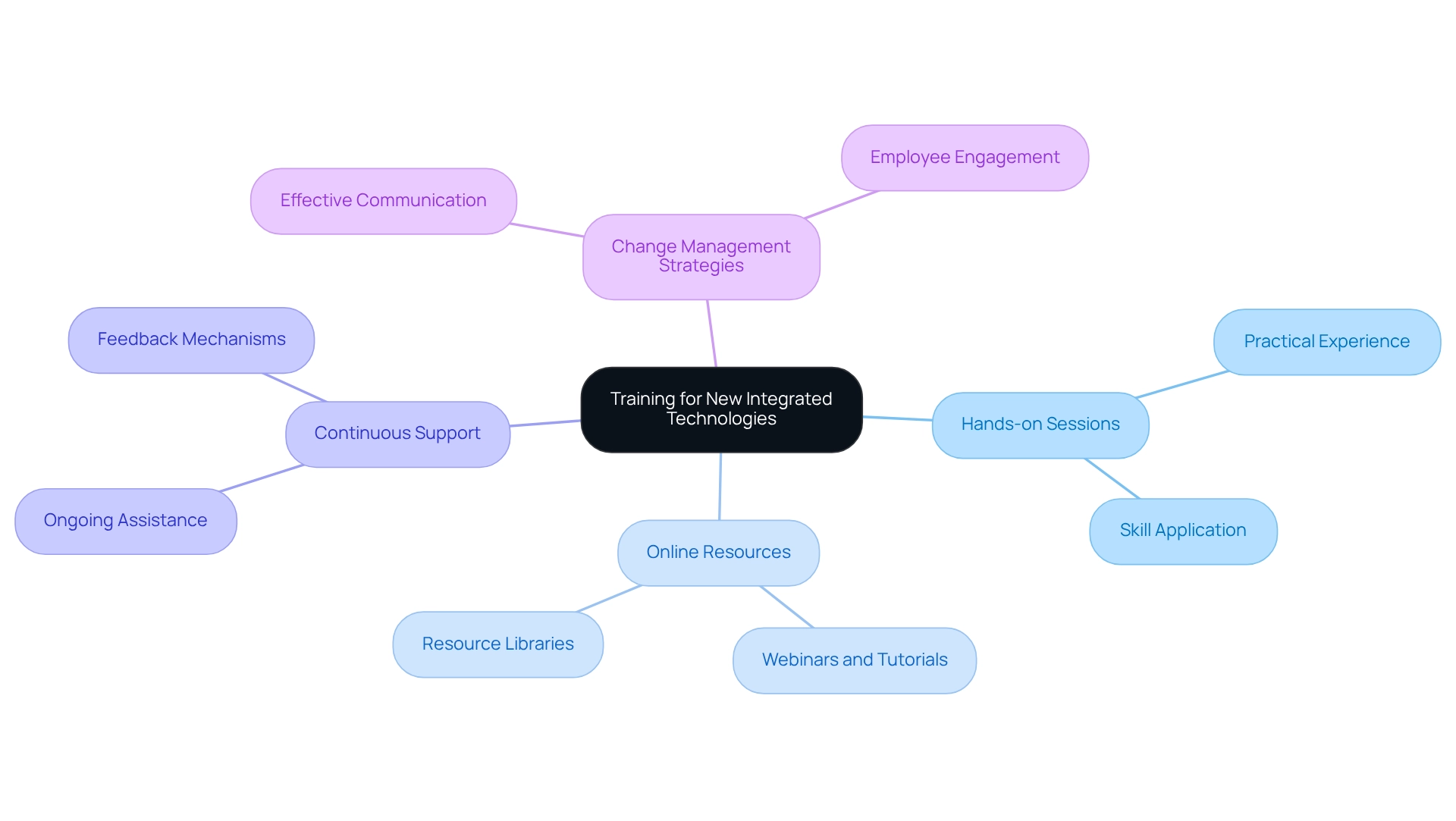
Select Appropriate Tools and Technologies for Integration
Selecting the appropriate tools and technologies for unification is not just important; it is crucial for successful digital transformation. We must carefully evaluate different connection platforms, middleware solutions, and APIs to identify options that align with our unique requirements. Key factors to consider include:
- Compatibility: We ensure that the selected tools can seamlessly integrate with existing legacy systems and modern applications, a core strength of our hybrid integration platform.
- Scalability: We choose solutions that can expand with our organization, addressing future data requirements and the complexity of connections, which we facilitate through our flexible architecture.
- Ease of Use: We look for platforms with intuitive interfaces and low-code capabilities, significantly reducing the learning curve and speeding up implementation. Our platform is designed with user-friendliness in mind, enabling teams to focus on strategic initiatives rather than technical hurdles.
- Real-Time Data Exchange: We prioritize tools that support real-time data connection, enhancing decision-making by providing a unified view of information. We excel in this area, unlocking isolated assets to deliver timely insights.
Our company, established by a team of devoted enterprise architects, represents a dedication to simplifying complex unification challenges. The name ‘Avato’ reflects this dedication, stemming from the Hungarian word for ‘of dedication.’ By utilizing the right tools, we can simplify our unification efforts, ensuring a smooth connection between legacy integrated technologies and modern systems. Successful instances abound, with entities reporting improved operational efficiency and decreased costs. For instance, data unification tools have been demonstrated to enhance decision-making abilities, highlighting the significance of choosing the appropriate solution. As Gustavo Estrada noted, “Avato has the ability to simplify complex projects and deliver results within desired time frames and budget constraints.”
As we assess connectivity platforms, we should also consider current trends, like the growing use of Change Data Capture (CDC) technologies, which enable real-time data synchronization. Grasping the pricing models of different connection tools is essential, as they vary from no-cost options to enterprise-level solutions, enabling us to select plans that suit our budget and growth requirements. We offer a variety of pricing plans tailored to different organizational needs, ensuring that businesses can find a solution that aligns with their financial and operational goals. Ultimately, a strategic method for choosing connection tools will enable us to manage the complexities of legacy integrated technologies linking effectively, particularly with our dedicated hybrid connection platform.

Implement Legacy Technologies in Phases to Minimize Disruption
Implementing legacy integrated technologies in stages is not just a strategy; it’s a powerful approach to minimizing disruption during the merging process. By dividing the project into manageable sections, we can focus on specific areas, conduct comprehensive testing of connections, and gather invaluable feedback before advancing to the next phase. This incremental method not only allows us to make modifications based on actual performance and user experiences but also significantly enhances the probability of a successful and less disruptive integration overall.
Furthermore, a strategic assessment and planning phase is essential. We begin with a thorough evaluation of our current systems, pinpointing areas that would benefit most from modernization. Collaborating closely with our solution provider, we create a comprehensive plan that aligns with our institution’s objectives and the evolving needs of our customers. This foresight enables us to identify potential issues early, allowing for timely resolutions that can prevent larger complications down the line.
Statistics reveal that investments in innovation can yield a profit increase of over 10%, particularly when we implement well-organized gradual incorporation strategies that align with our operational objectives. In sectors like banking and healthcare, where secure and dependable unification is paramount, this method effectively reduces significant implementation expenses and economic uncertainties that often hinder digital transformation initiatives.
Expert opinions underscore the importance of minimizing disruption during technology implementation to maintain operational efficiency. Iva Krasteva, a content creator expert, states that “embracing generative AI is becoming crucial for businesses aiming to stay competitive and innovative in a rapidly evolving landscape.” By adopting a phased approach, we can enhance our assimilation results and utilize legacy integrated technologies to adapt swiftly to changing market demands, ensuring we remain competitive in a dynamic environment.
To initiate the application of a phased strategy in our development projects, we recommend starting with a pilot program that focuses on a specific legacy system. This allows us to test and refine our approach before expanding to more complex integrations.
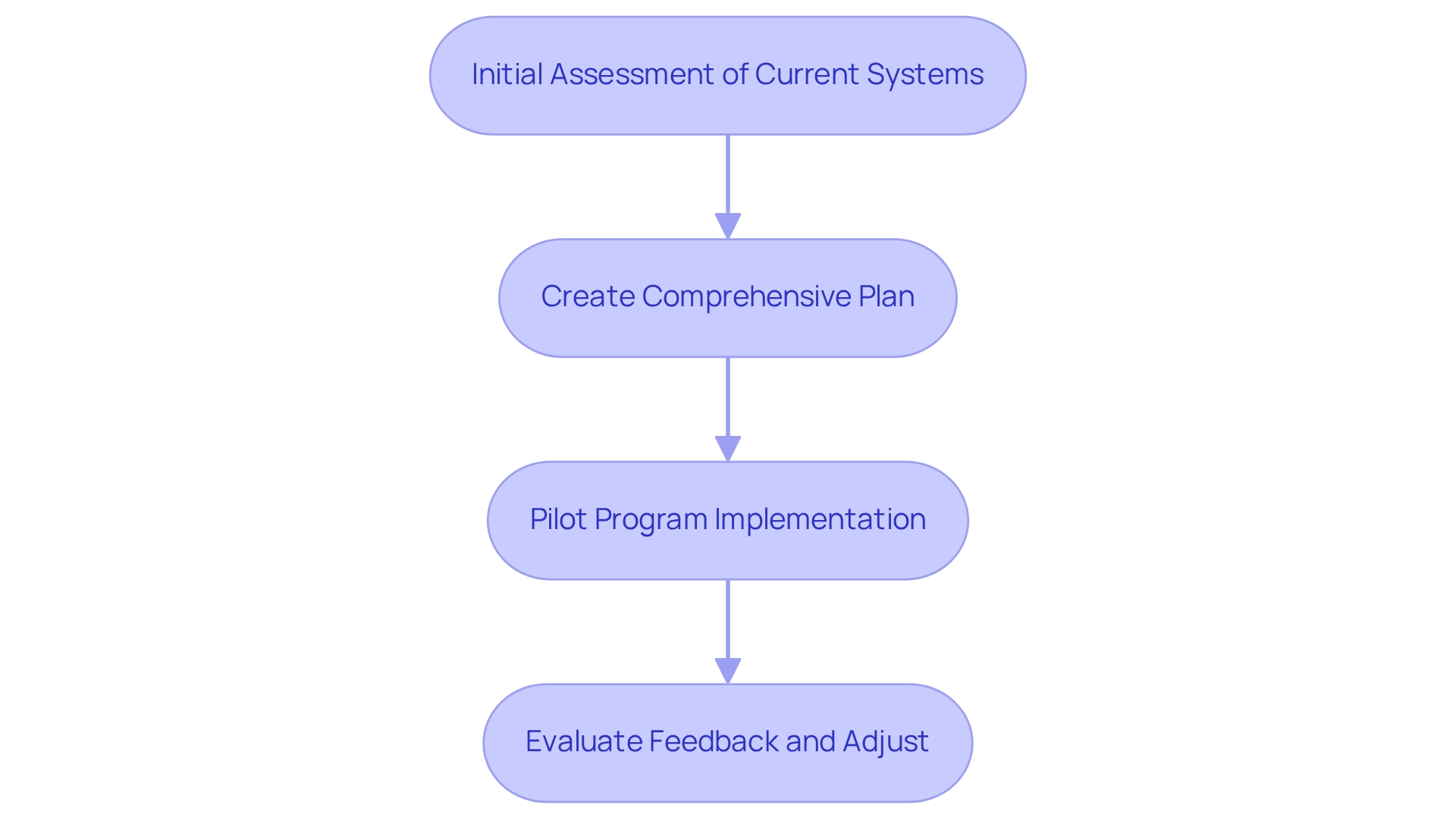
Monitor and Evaluate Integration Processes Regularly
Regular monitoring and evaluation of integration processes are essential for ensuring alignment with our organizational objectives. This entails methodically monitoring key performance indicators (KPIs), collecting user feedback, and evaluating overall performance. By establishing a routine evaluation process, we can pinpoint areas needing improvement, swiftly address emerging issues, and make informed, data-driven decisions regarding future enhancements. This proactive strategy not only maintains the integrity of our infrastructure but also encourages ongoing optimization of legacy integrated technologies.
Key performance indicators frequently utilized in our monitoring include system uptime, response times, and user satisfaction metrics. For instance, we ensure 24/7 uptime for essential connections, underscoring the significance of reliability in sustaining operational continuity. Furthermore, organizations that implement effective API monitoring can evaluate performance from multiple perspectives, catering to the needs of testers, developers, and product owners alike. This multi-faceted strategy enables us to enhance API performance, ensuring that our connection processes meet diverse stakeholder requirements.
In 2025, best practices for overseeing processes will emphasize the significance of KPIs in technological assimilation. Frequent assessments assist us in preserving a competitive advantage while aligning our unification efforts with wider business objectives. Statistics show that 70% of companies perform evaluation assessments at least quarterly, underscoring the importance of this practice in today’s fast-paced digital environment. By engaging stakeholders to precisely outline requirements and designing new business processes, we can improve our unification strategies.
Utilizing expert insights, like Dr. Joe Perez’s claim that ‘by following these steps, you can effectively benchmark and compare your data performance,’ along with successful examples of KPI tracking, we can promote ongoing enhancement. Furthermore, employing the appropriate tools and methods to demonstrate the present and optimal condition of our connection processes is vital for efficient oversight. Future-proofing our systems guarantees that our unification strategies remain applicable as new tools are introduced. Our dedication to delivering a dependable system stack further aids organizations in reaching their integration objectives and sustaining a competitive edge.
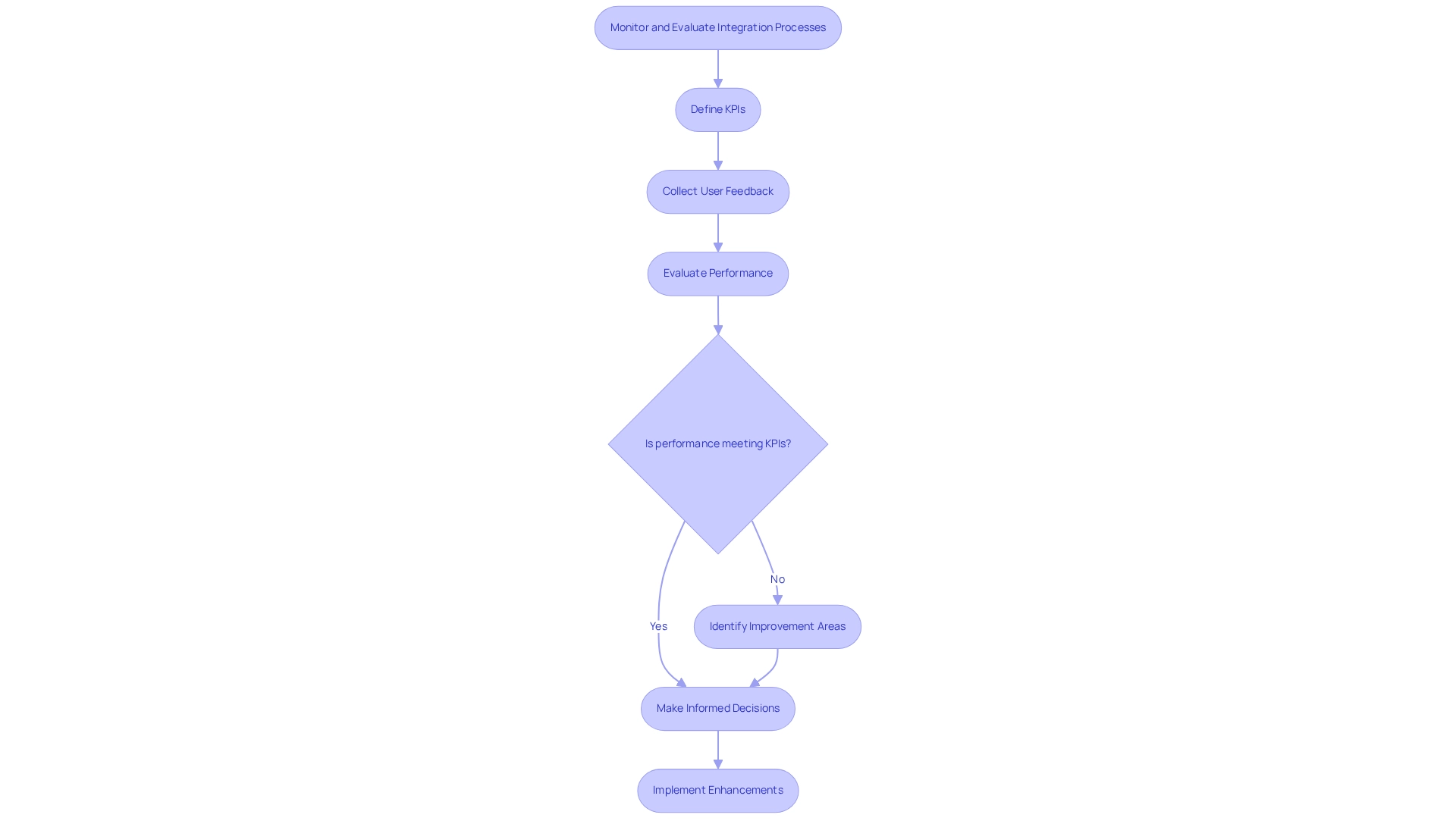
Establish Ongoing Support for Integrated Technologies
Establishing ongoing support for integrated systems is not just beneficial; it is crucial for their sustained success. This support encompasses technical assistance, troubleshooting resources, and regular updates to ensure our systems operate efficiently. We must prioritize the creation of a dedicated support team capable of addressing user inquiries, resolving issues swiftly, and driving continuous improvement. A robust support framework not only enhances user satisfaction but also maintains the effectiveness of integrated technologies over time.
Statistics indicate that 75% of businesses derive significant value from their investments in IT automation, underscoring the necessity of ongoing support. Furthermore, two-thirds of IT specialists acknowledge the significance of security certifications for career progression, emphasizing the necessity of skilled support staff in managing intricate systems. As a result, with a projected year-over-year rise of 9% in total IT expenditure, investing in continuous support becomes progressively essential for companies striving to remain competitive.
Effective continuous support encompasses several crucial elements:
- Prompt response to technical problems
- Proactive monitoring of infrastructure
- Regular training sessions for users
A solid base offered by a hybrid unification platform allows us to effortlessly link disconnected systems with contemporary solutions, including legacy integrated technologies, promoting smoother transitions and enhanced operational efficiency. This includes secure data sharing and real-time access to data, which are essential for informed decision-making. Successful cases of technical assistance in legacy integrated technologies demonstrate that companies can achieve higher conversion rates and enhanced customer loyalty when they invest in dedicated resources, particularly through AI-driven personalization. By fostering a culture of support and responsiveness, we can ensure our combined systems not only meet current needs but also adapt to future challenges. Additionally, as Gen Z respondents increasingly value technological advancements, we must be prepared to support these changes effectively. To further enhance the credibility of this section, we should incorporate additional quotes from IT support leaders on the importance of ongoing technical assistance, providing valuable insights that reinforce our commitment to excellence.
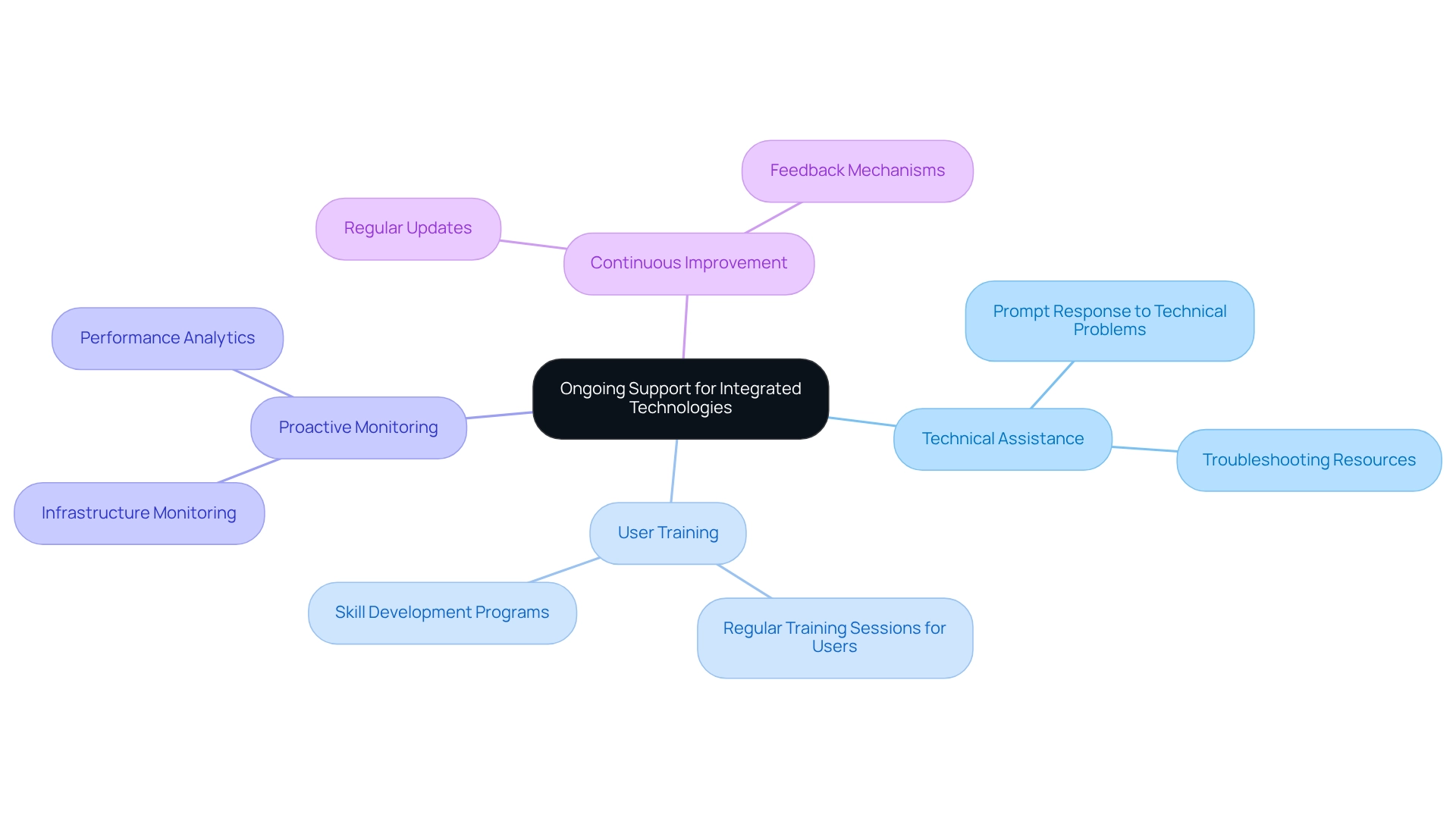
Adapt Integration Strategies to Evolving Technology and Business Needs
We must proactively adjust our unification strategies to meet the demands of advancing innovations and changing business environments. This requires a keen awareness of emerging trends and a thorough assessment of how new technologies impact existing systems. Adopting a culture of agility and innovation is essential; it enables us to adjust effectively when needed, ensuring that our collaborative efforts consistently provide value and align with strategic goals.
Statistics show that shadow IT represents 30-40% of total IT expenditures at large firms, emphasizing the necessity for businesses to enhance their coordination strategies to reduce potential security and compliance risks. Our hybrid unification platform is intended to tackle these challenges, offering strong security protocols that assist entities in managing the complexities of shadow IT while guaranteeing adherence to industry regulations. By regularly revisiting and enhancing these strategies, we can maintain a competitive edge and remain responsive in a rapidly changing market.
Successful examples of agile incorporation strategies can be observed in industries projected for significant growth, such as UAV manufacturing, which is expected to expand by 44.7% between 2023 and 2024. Our platform can assist in quickly and effectively connecting legacy integrated technologies with new solutions in rapidly expanding sectors. These trends highlight the necessity for businesses to adjust their incorporation methods to leverage new technologies effectively. As Louis Columbus remarked, “Cloud-based data unification is the new standard in enterprises,” reflecting the shift towards more flexible and scalable connection solutions. We embody this shift by providing a platform that facilitates seamless cloud-based connectivity, enabling businesses to innovate without compromise.
The name ‘Avato’ originates from the Hungarian term for ‘of dedication,’ which embodies our commitment to crafting the infrastructure needed to enhance rich, connected customer experiences. Ultimately, organizations that prioritize agility in their unification strategies will be better positioned to navigate the complexities of modern technology and capitalize on emerging opportunities. Our capabilities in enabling agile integration ensure that businesses can respond to market changes swiftly, enhancing their operational efficiency and effectiveness.
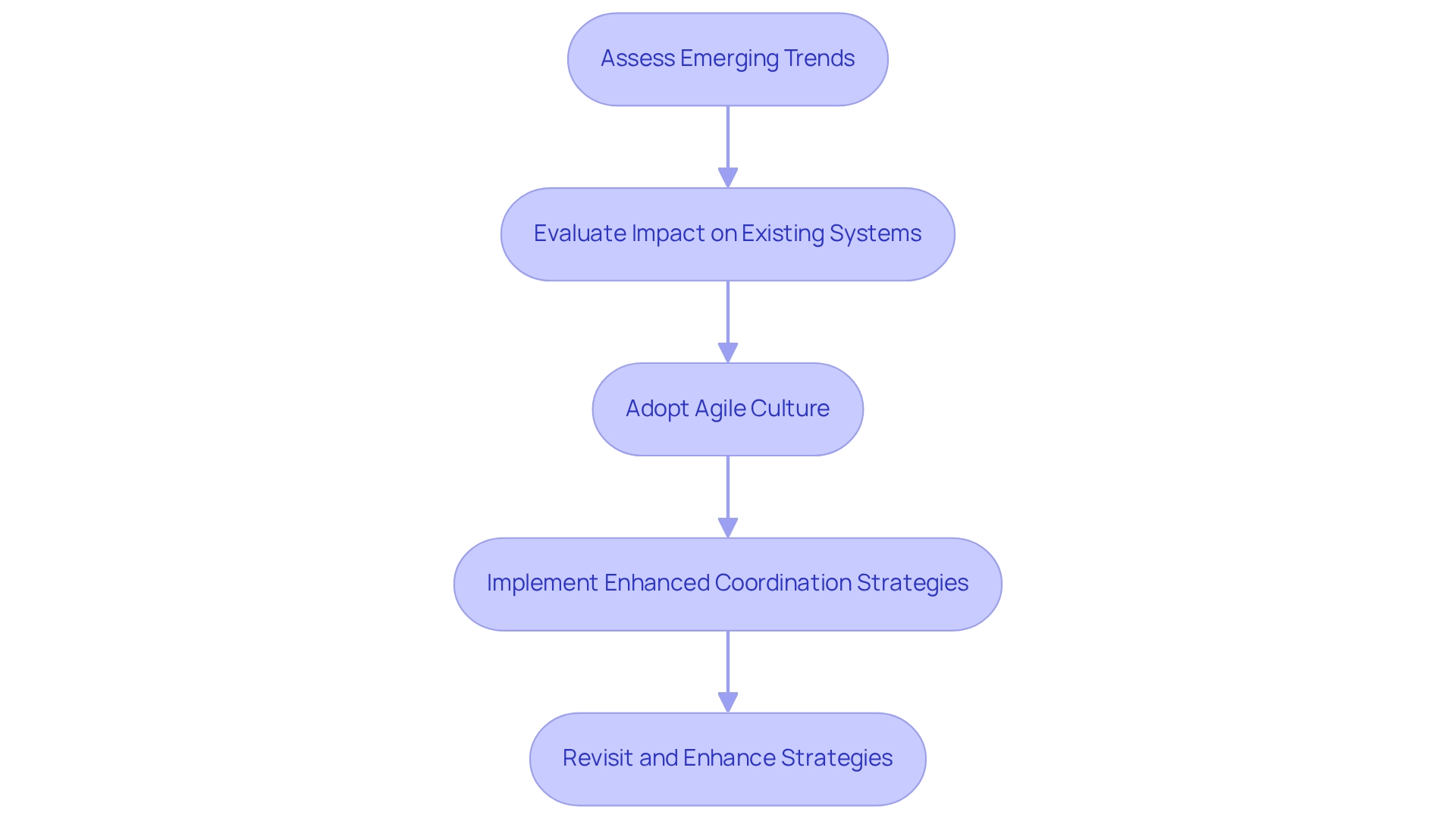
Conclusion
In today’s rapidly evolving technological landscape, the integration of legacy systems with modern solutions is not merely a challenge; it is a necessity for organizations aspiring to thrive. We recognize that the strategies we outline—ranging from comprehensive assessments of existing systems to engaging stakeholders across departments—underscore the importance of a structured approach to integration. By leveraging Avato’s secure hybrid integration platform, we can modernize our operations while prioritizing security and performance.
The significance of developing a clear integration strategy cannot be overstated. A well-defined plan, tailored to our specific needs, serves as a roadmap for successful implementation. Engaging stakeholders throughout the process fosters collaboration and transparency, essential for addressing diverse needs and ensuring alignment with our organizational objectives. Furthermore, investing in staff training and ongoing support enhances user confidence, facilitating a smoother transition to new integrated technologies.
Adopting a phased approach to implementation minimizes disruption, allowing us to test integrations and make informed adjustments along the way. Regular monitoring and evaluation of integration processes ensure that we remain aligned with our goals and can adapt to changing demands. As technology continues to evolve, our ability to adapt integration strategies is critical for maintaining a competitive edge.
Ultimately, the journey towards seamless integration requires dedication, expertise, and a commitment to continuous improvement. By embracing these strategies and leveraging the capabilities of Avato, we can navigate the complexities of legacy system integration, unlocking new opportunities for growth and innovation. The future belongs to those who dare to integrate and innovate, positioning ourselves for success in a rapidly changing digital landscape.

